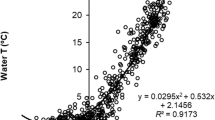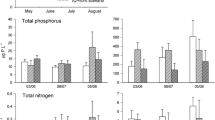Abstract
In the years 2004 and 2005, we collected samples of phytoplankton, zooplankton, and macroinvertebrates in an artificial small pond in Budapest (Hungary). We set up a simulation model predicting the abundances of the cyclopoids, Eudiaptomus zachariasi, and Ischnura pumilio by considering only temperature and the abundance of population of the previous day. Phytoplankton abundance was simulated by considering not only temperature but the abundances of the three mentioned groups. When we ran the model with the data series of internationally accepted climate change scenarios, the different outcomes were discussed. Comparative assessment of the alternative climate change scenarios was also carried out with statistical methods.














Similar content being viewed by others
References
Arashkevich, E., Wassmann, P., Pasternak, A., & Riser, C. W. (2002). Seasonal and spatial changes in biomass, structure, and development progress of the zooplankton community in the Barents Sea. Journal of Marine Systems, 38, 125–145. DOI 10.1016/S0924-7963(02)00173-2.
Baranovic, A., Solic, M., Vucetic, T., & Krstulovic, N. (1993). Temporal fluctuations of zooplankton and bacteria in the middle Adriatic Sea. Marine Ecology Progress Series, 92, 65–75. DOI 10.3354/meps092065.
Barrow, E. M., Hulme, M., Semenov, M. A., & Brooks, R. J. (2000). Climate change scenarios. In T. E. Downing, P. A. Harrison, R. E. Butterfield, & K. G. Lonsdale (Eds.), Climate change, climatic variability and agriculture in Europe: An integrated assessment (pp. 11–27). Oxford, UK: University of Oxford.
Bernot, R. J., Dodds, W. K., Quist, M. C., & Guy, C. S. (2004). Spatial and temporal variability of zooplankton in a great plains reservoir. Hydrobiologia, 525, 101–112. DOI 10.1023/B:HYDR.0000038857.19342.fd.
Carter, T. R., Parry, M. L., Harasawa, H., & Nishioka, S. (1994). IPCC technical guidelines for assessing climate change impacts and adaptation p. 59. London: UCL/CGER.
Christensen, J. H. (2005). Prediction of regional scenarios and uncertainties for defining European climate change risks and effects. Final Report. p. 269. Copenhagen: DMI.
Christoffersen, K., Andersen, N., Sondergaard, M., & Liboriussen, L. (2006). Implications of climate-enforced temperature increases on freshwater pico- and nanoplankton populations studied in artificial ponds during 16 months. Hydrobiologia, 560, 259–266. DOI 10.1007/s10750-005-12212.
Christou, E. D. (1998). Interannual variability of copepods in a Mediterranean coastal area (Saronikus Gulf, Aegean Sea). Journal of Marine Systems, 15, 523–532. DOI 10.1016/S0924-7963(97)00080-8.
Christou, E. D., & Moraitou-Apostolopoulou, M. (1995). Metabolism and feeding of mesozooplankton at the eastern Mediterranean (Hellenic coastal waters). Marine Ecology Progress Series, 126, 39–48. DOI 10.3354/meps126039.
Dippner, J. W., Kornilovs, G., & Sidrevics, L. (2000). Long-term variability of mesozooplankton in the Central Baltic Sea. Journal of Marine Systems, 25, 23–31. DOI 10.1016/S0924-7963(00)00006-3.
Hammer, O., Harper, D. A. T., & Ryan, P. D. (2001). PAST: Paleontological statistics software package for education and data analysis. Paleontologia Electronica, 4(1), 9.
Harrison, P. A., Butterfield, R. E., & Downing, T. E. (2000). The CLIVARA project: Study aims and methods. In T. E. Downing, P. A. Harrison, R. E. Butterfield, & K. G. Lonsdale (Eds.), Climate change, climatic variability and agriculture in Europe: An integrated Assessment (pp. 3–10). Oxford, UK: University of Oxford.
Iguchi, N. (2004). Spatial/temporal variations in zooplankton biomass and ecological characteristics of major species in the southern part of the Japan Sea: A review. Progress in Oceanography, 61, 213–225. DOI 10.1016/j.pocean.2004.06.007.
IPCC (2007). Climate change 2007: The physical science basis. Working group I contribution to the fourth assessment Report of the IPCC. Intergovernmental Panel on Climate Change. New York: Cambridge University Press.
Jackson, J. K., & Füreder, L. (2006). Long-term studies of freshwater macroinvertebrates: A review of the frequency, duration and ecological significance. Freshwater Biology, 51, 591–603. DOI 10.1111/j.1365-2427.2006.01503.x.
Jorgensen, S. E. (1994). Fundamentals of ecological modeling (developments in environmental modeling 19) (2nd ed.). Amsterdam: Elsevier.
Jorgensen, E. S., & Padisák, J. (1996). Does the intermediate disturbance hypothesis comply with thermodynamics? Hydrobiologia, 323, 9–21.
Mackas, D. L., & Tsuda, A. (1999). Mesozooplankton in the eastern and western subarctic Pacific: Community structure, seasonal life histories, and interannual variability. Progress in Oceanography, 43, 335–363. DOI 10.1016/S0079-6611(99)00012-9.
Marosi, S., & Somogyi, S. (1990). Magyarország kistájainak katasztere I–II. Budapest: MTA Földrajztudományi Kutatóintézet.
McKee, D., & Atkinson, D. (2000). The influence of climate change scenarios on population of the mayfly Cloeon dipterum. Hydrobiologia, 441, 55–62. DOI 10.1023/A:1017595223819.
Meise-Munns, C., Green, J., Ingham, M., & Mountain, D. (1990). Interannual variability in the copepod populations of George Bank and the western Gulf of Maine. Marine Ecology Progress Series, 65, 225–232. DOI 10.3354/meps065225.
Minnen, J. G., Onigkeit, O., & Alcamo, J. (2002). Critical climate change as an approach to assess climate change impacts in Europe: Development and application. Environmental Science & Policy, 5, 335–347. DOI 10.1016/S1462-9011(02)00044-8.
Peperzak, L. (2003). Climate change and harmful algal blooms in the North Sea. Acta Oecologica, 24, 139–144. DOI 10.1016/S1146-609X(03)00009-2.
Puelles, M. L. F., Pinot, J. M., & Valencia, J. (2003). Seasonal and interannual variability of zooplankton community in waters of Mallorca island (Baleric Sea, Western Mediterranean). 1994–1999. Oceanologica Acta, 26, 673–686. DOI 10.1016/j.oceact.2003.07.001.
Sipkay, Cs., & Hufnagel, L. (2006). Szezonális dinamikai folyamatok egy balatoni makrogerinctelen együttesben. Acta Biologica Debrecina Supplementum Oecologica Hungarica, 14, 211–222.
Sipkay, Cs., & Hufnagel, L. (2007). Klímaváltozási szcenáriók összehasonlító elemzése balatoni makrogerinctelen együttes alapján. Hidrológiai Közlöny, 87, 117–119.
Sipkay, Cs., Nosek, J., Oertel, N., Vadadi-Fülöp, Cs., & Hufnagel, L. (2007). Klímaváltozási szcenáriók elemzése egy dunai Copepoda faj szezonális dinamikájának modellezése alapján. Klíma 21. Füzetek, 49, 80–90.
Somlyódi, L., Herodek, S., & Fisher, F. (1983). Eutrophication of shallow lakes: Modeling and management. Luxemburg: IIASA.
Sommer, U. (1989). Plankton ecology: Succession in plankton communities. New York: Springer.
Sommer, U., Gliwicz, Z. M., Lampert, W., & Duncan, A. (1986). The PEG-model of seasonal succession of planctonic events in freshwaters. Archiv fuer Hydrobiologie, 106, 433–471.
Sommer, U., Padisák, J., Reynolds, C. S., & Juhász-Nagy, P. (1993). Hutchinson’s heritage: The diversity–disturbance relationship in phytoplankton. Hydrobiologia, 249, 1–8. DOI 10.1007/BF00008837.
Straile, D. (2005). Food webs in lakes—Seasonal dynamics and the impacts of climate variability. In A. Belgrano, U. Scharler, J. Dunne, & B. Ulanowitz (Eds.), Aquatic food webs: An ecosystem approach (pp. 41–50). Oxford, UK: Oxford University Press.
Tilman, D. (1982). Resource competition and community structure. Princeton: Princeton University Press.
Tilman, D., Kilham, S. S., & Kilham, D. (1982). Phytoplankton community ecology: The role of limiting nutrients. Annual Review of Ecology and Systematics, 13, 349. DOI 10.1146/annurev.es.13.110182.002025.
Vadadi-Fülöp, Cs., Sipkay, Cs., & Hufnagel, L. (2007). Klímaváltozási szcenáriók értékelése egy szitakötőfaj (Ischnura pumilio Charpentier, 1825) szezonális dinamikája alapján. Acta Biologica Debrecina Supplementum Oecologica Hungarica, 16, 211–219.
Varga-Haszonits, Z. (2003). Az éghajlatváltozás mezőgazdasági hatásának elemzése, éghajlati szcenáriók. AGRO-21. Füzetek, 31, 9–27.
Viitasalo, M., Vuorinen, I., & Ranta, E. (1990). Changes in crustacean mesozooplankton and some environmental parameters in the Archipelago Sea (Northern Baltic) in 1976–1984. Ophelia, 31, 207–217.
Acknowledgments
This investigation was supported by the projects NKFP 4/037/2001 and the OTKA T042583. The present paper is a contribution to the CLIVARA and PRUDENCE projects. Meteorological data were provided by the Hungarian Meteorological Office. Department of Systematic Zoology and Ecology, Eötvös Loránd University, and Department of Mathematics and Informatics, Corvinus University of Budapest, supported this research.
Author information
Authors and Affiliations
Corresponding author
Rights and permissions
About this article
Cite this article
Vadadi-Fülöp, C., Türei, D., Sipkay, C. et al. Comparative Assessment of Climate Change Scenarios Based on Aquatic Food Web Modeling. Environ Model Assess 14, 563–576 (2009). https://doi.org/10.1007/s10666-008-9158-2
Received:
Accepted:
Published:
Issue Date:
DOI: https://doi.org/10.1007/s10666-008-9158-2




